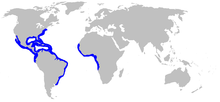
Back قرش ليموني Arabic قرش ليمونى ARZ Лимонова акула Bulgarian লেমন শার্ক Bengali/Bangla Tauró llimona Catalan Negaprion brevirostris CEB Žralok citronový Czech Zitronenhai German Κίτρινος καρχαρίας Greek Negaprion brevirostris Spanish
| Lemon shark | |
|---|---|

| |
| Scientific classification | |
| Domain: | Eukaryota |
| Kingdom: | Animalia |
| Phylum: | Chordata |
| Class: | Chondrichthyes |
| Subclass: | Elasmobranchii |
| Subdivision: | Selachimorpha |
| Order: | Carcharhiniformes |
| Family: | Carcharhinidae |
| Genus: | Negaprion |
| Species: | N. brevirostris
|
| Binomial name | |
| Negaprion brevirostris (Poey, 1868)
| |

| |
| Range of the lemon shark | |
| Synonyms | |
| |
The lemon shark (Negaprion brevirostris) is a species of shark from the family Carcharhinidae, known for its yellowish color, which even gives it its popular name. It is classified as a Vulnerable species by the International Union for the Conservation of Nature.[4] Lemon sharks can grow to 3.4 metres (11 ft) in length. They are often found in shallow subtropical waters and are known to inhabit and return to specific nursery sites for breeding. Often feeding at night, these sharks use electroreceptors to find their main source of prey, fish. Lemon sharks enjoy the many benefits of group living such as enhanced communication, courtship, predatory behavior, and protection. This species of shark gives birth to live young, and the females are polyandrous and have a biennial reproductive cycle. Lemon sharks are not thought to be a large threat to humans; there have been 10 recorded bites, none of which were life-threatening. The lemon shark's life span is unknown, but the average shark is 25 to 30 years old.[5] The oldest recorded lemon shark in captivity died in 2023 at the age of 40 years.[6]
- ^ "Negaprion brevirostris". the Paleontological database.org.
- ^ Carlson, J.; Charvet, P.; Ba, A.; Bizzarro, J.; Derrick, D.; Espinoza, M.; Doherty, P.; Chartrain, E.; Dia, M.; Leurs, G.H.L.; Metcalfe, K.; Pires, J.D.; Pacoureau, N.; Porriños, G.; Dulvy, N.K. (2021). "Negaprion brevirostris". IUCN Red List of Threatened Species. 2021: e.T39380A2915472. doi:10.2305/IUCN.UK.2021-1.RLTS.T39380A2915472.en. Retrieved 19 November 2021.
- ^ Cite error: The named reference
fishbasewas invoked but never defined (see the help page). - ^ Nam, Dong-Ha; Adams, Douglas H.; Reyier, Eric A.; Basu, Niladri (2011). "Mercury and selenium levels in lemon sharks (Negaprion brevirostris) in relation to a harmful red tide event". Environmental Monitoring and Assessment. 176 (1–4): 549–559. doi:10.1007/s10661-010-1603-4. ISSN 0167-6369. PMID 20625820. S2CID 26744956.
- ^ "Lemon Shark". gwinnett.k12.ga.us. Retrieved 2019-08-27.
- ^ "World's Oldest Lemon Shark Passes Away at Plymouth Aquarium – Your Aquarium". 2023-07-01. Retrieved 2024-04-13.
